Essay: Accounting Fundamentals, Financial Statements & Analysis
VerifiedAdded on 2023/01/10
|13
|2971
|81
Essay
AI Summary
This essay provides a comprehensive overview of accounting fundamentals, beginning with journal entries and culminating in the preparation and analysis of financial statements. The essay covers the formulation of trial balances, profit and loss accounts, and balance sheets, emphasizing their relevance to various users, including investors, employees, and government entities. A significant portion is dedicated to contrasting and comparing liquidity and profitability, highlighting their distinct roles in assessing a company's financial health. Through detailed explanations and practical examples, the essay illustrates how financial statements serve as crucial tools for decision-making, both internally and externally, ensuring stakeholders can assess a company's performance and make informed strategic choices. The essay also delves into the relevance of financial statements for different users, such as suppliers, investors, and creditors, and how these statements inform their respective decision-making processes. Finally, the essay explores the differences and similarities between liquidity and profitability, emphasizing their roles in the financial health of a company.
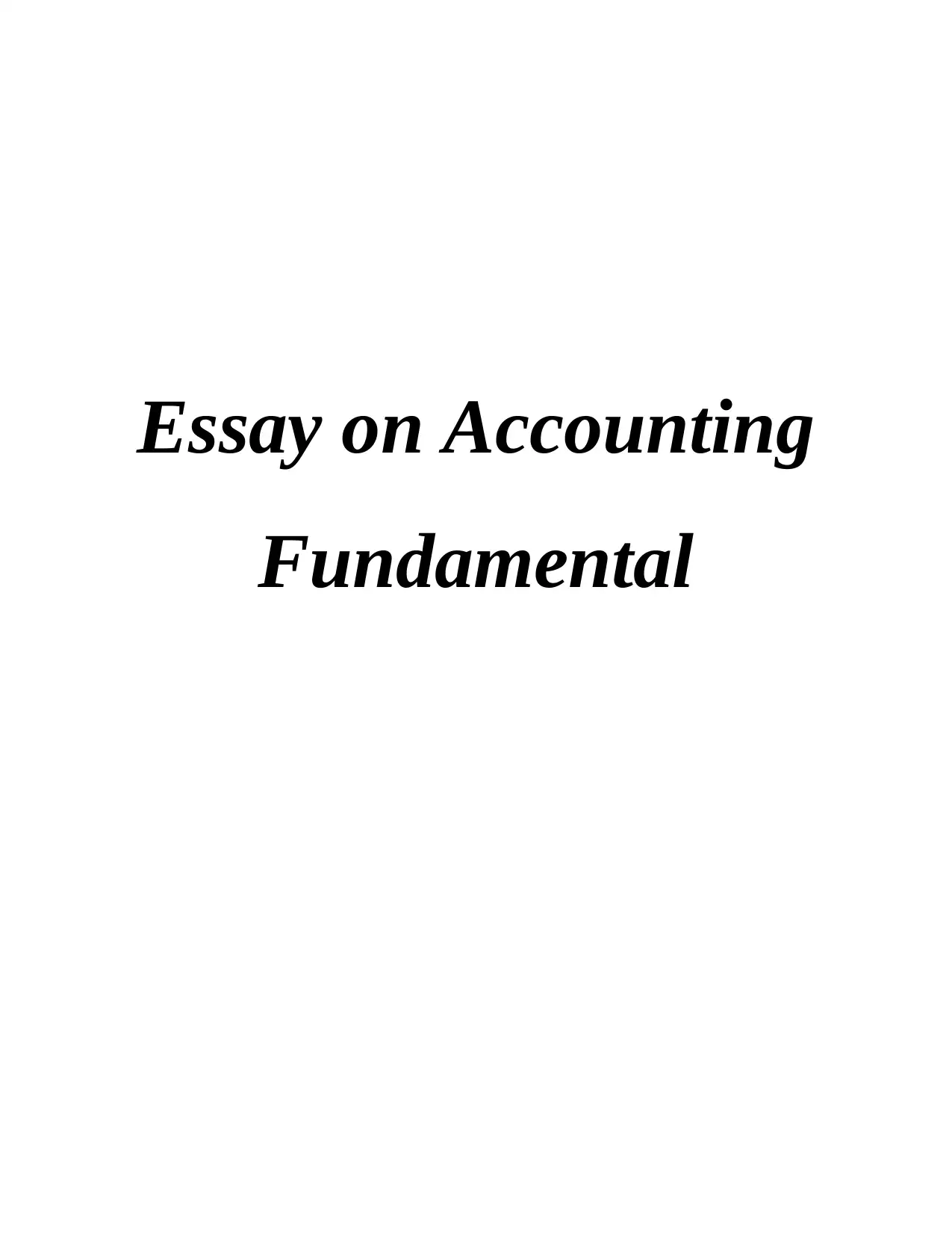
Essay on Accounting
Fundamental
Fundamental
Paraphrase This Document
Need a fresh take? Get an instant paraphrase of this document with our AI Paraphraser
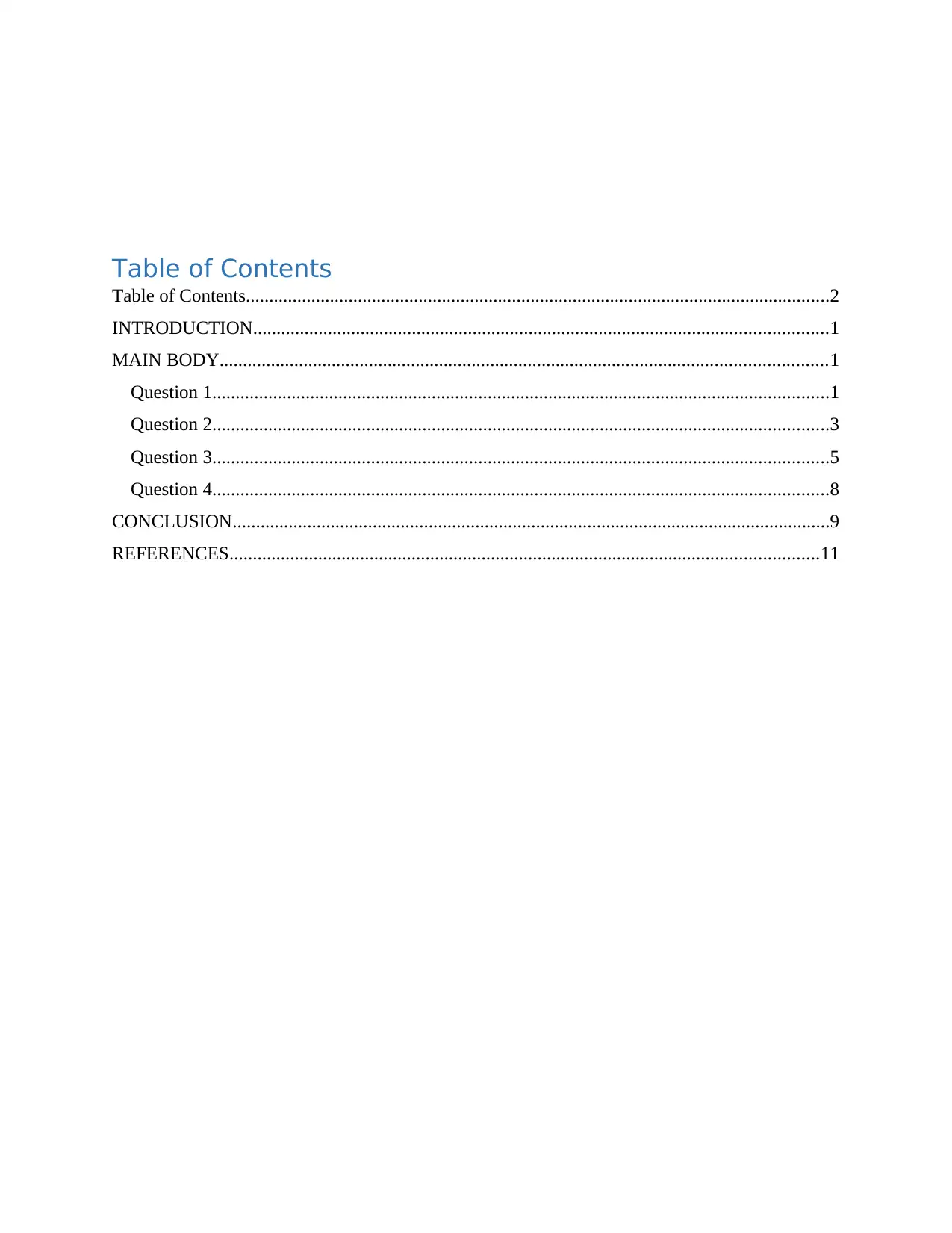
Table of Contents
Table of Contents.............................................................................................................................2
INTRODUCTION...........................................................................................................................1
MAIN BODY..................................................................................................................................1
Question 1....................................................................................................................................1
Question 2....................................................................................................................................3
Question 3....................................................................................................................................5
Question 4....................................................................................................................................8
CONCLUSION................................................................................................................................9
REFERENCES..............................................................................................................................11
Table of Contents.............................................................................................................................2
INTRODUCTION...........................................................................................................................1
MAIN BODY..................................................................................................................................1
Question 1....................................................................................................................................1
Question 2....................................................................................................................................3
Question 3....................................................................................................................................5
Question 4....................................................................................................................................8
CONCLUSION................................................................................................................................9
REFERENCES..............................................................................................................................11
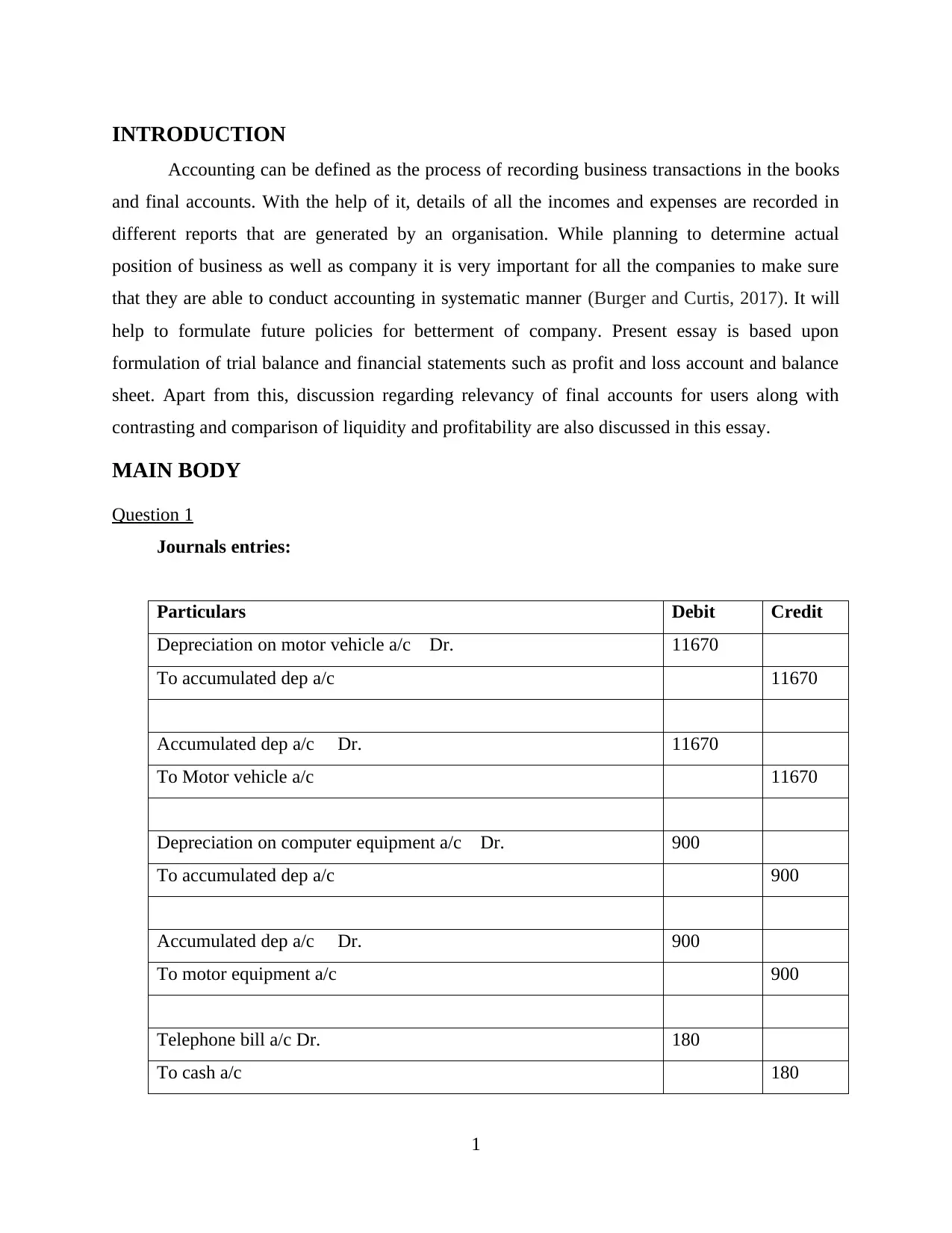
INTRODUCTION
Accounting can be defined as the process of recording business transactions in the books
and final accounts. With the help of it, details of all the incomes and expenses are recorded in
different reports that are generated by an organisation. While planning to determine actual
position of business as well as company it is very important for all the companies to make sure
that they are able to conduct accounting in systematic manner (Burger and Curtis, 2017). It will
help to formulate future policies for betterment of company. Present essay is based upon
formulation of trial balance and financial statements such as profit and loss account and balance
sheet. Apart from this, discussion regarding relevancy of final accounts for users along with
contrasting and comparison of liquidity and profitability are also discussed in this essay.
MAIN BODY
Question 1
Journals entries:
Particulars Debit Credit
Depreciation on motor vehicle a/c Dr. 11670
To accumulated dep a/c 11670
Accumulated dep a/c Dr. 11670
To Motor vehicle a/c 11670
Depreciation on computer equipment a/c Dr. 900
To accumulated dep a/c 900
Accumulated dep a/c Dr. 900
To motor equipment a/c 900
Telephone bill a/c Dr. 180
To cash a/c 180
1
Accounting can be defined as the process of recording business transactions in the books
and final accounts. With the help of it, details of all the incomes and expenses are recorded in
different reports that are generated by an organisation. While planning to determine actual
position of business as well as company it is very important for all the companies to make sure
that they are able to conduct accounting in systematic manner (Burger and Curtis, 2017). It will
help to formulate future policies for betterment of company. Present essay is based upon
formulation of trial balance and financial statements such as profit and loss account and balance
sheet. Apart from this, discussion regarding relevancy of final accounts for users along with
contrasting and comparison of liquidity and profitability are also discussed in this essay.
MAIN BODY
Question 1
Journals entries:
Particulars Debit Credit
Depreciation on motor vehicle a/c Dr. 11670
To accumulated dep a/c 11670
Accumulated dep a/c Dr. 11670
To Motor vehicle a/c 11670
Depreciation on computer equipment a/c Dr. 900
To accumulated dep a/c 900
Accumulated dep a/c Dr. 900
To motor equipment a/c 900
Telephone bill a/c Dr. 180
To cash a/c 180
1
⊘ This is a preview!⊘
Do you want full access?
Subscribe today to unlock all pages.

Trusted by 1+ million students worldwide
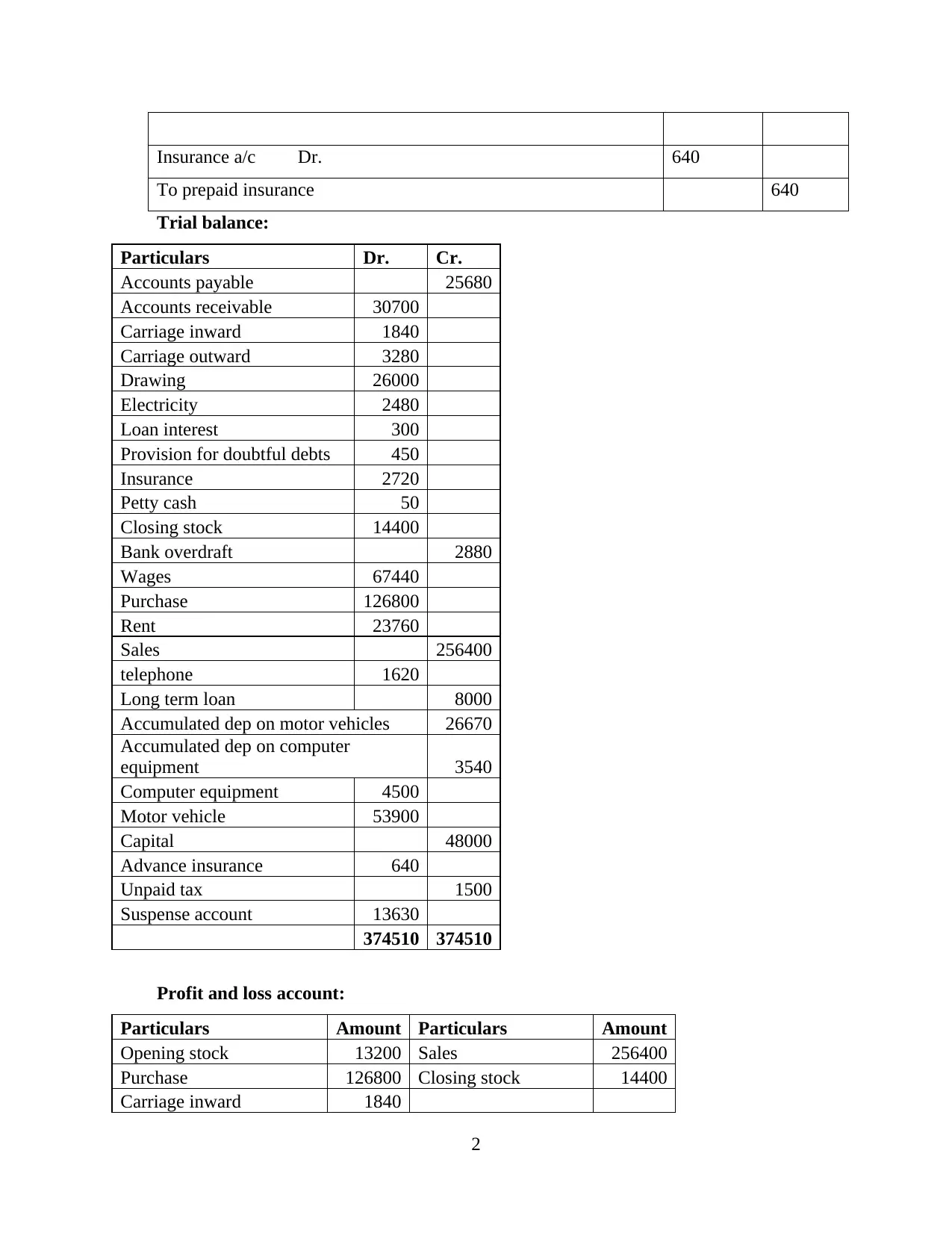
Insurance a/c Dr. 640
To prepaid insurance 640
Trial balance:
Particulars Dr. Cr.
Accounts payable 25680
Accounts receivable 30700
Carriage inward 1840
Carriage outward 3280
Drawing 26000
Electricity 2480
Loan interest 300
Provision for doubtful debts 450
Insurance 2720
Petty cash 50
Closing stock 14400
Bank overdraft 2880
Wages 67440
Purchase 126800
Rent 23760
Sales 256400
telephone 1620
Long term loan 8000
Accumulated dep on motor vehicles 26670
Accumulated dep on computer
equipment 3540
Computer equipment 4500
Motor vehicle 53900
Capital 48000
Advance insurance 640
Unpaid tax 1500
Suspense account 13630
374510 374510
Profit and loss account:
Particulars Amount Particulars Amount
Opening stock 13200 Sales 256400
Purchase 126800 Closing stock 14400
Carriage inward 1840
2
To prepaid insurance 640
Trial balance:
Particulars Dr. Cr.
Accounts payable 25680
Accounts receivable 30700
Carriage inward 1840
Carriage outward 3280
Drawing 26000
Electricity 2480
Loan interest 300
Provision for doubtful debts 450
Insurance 2720
Petty cash 50
Closing stock 14400
Bank overdraft 2880
Wages 67440
Purchase 126800
Rent 23760
Sales 256400
telephone 1620
Long term loan 8000
Accumulated dep on motor vehicles 26670
Accumulated dep on computer
equipment 3540
Computer equipment 4500
Motor vehicle 53900
Capital 48000
Advance insurance 640
Unpaid tax 1500
Suspense account 13630
374510 374510
Profit and loss account:
Particulars Amount Particulars Amount
Opening stock 13200 Sales 256400
Purchase 126800 Closing stock 14400
Carriage inward 1840
2
Paraphrase This Document
Need a fresh take? Get an instant paraphrase of this document with our AI Paraphraser
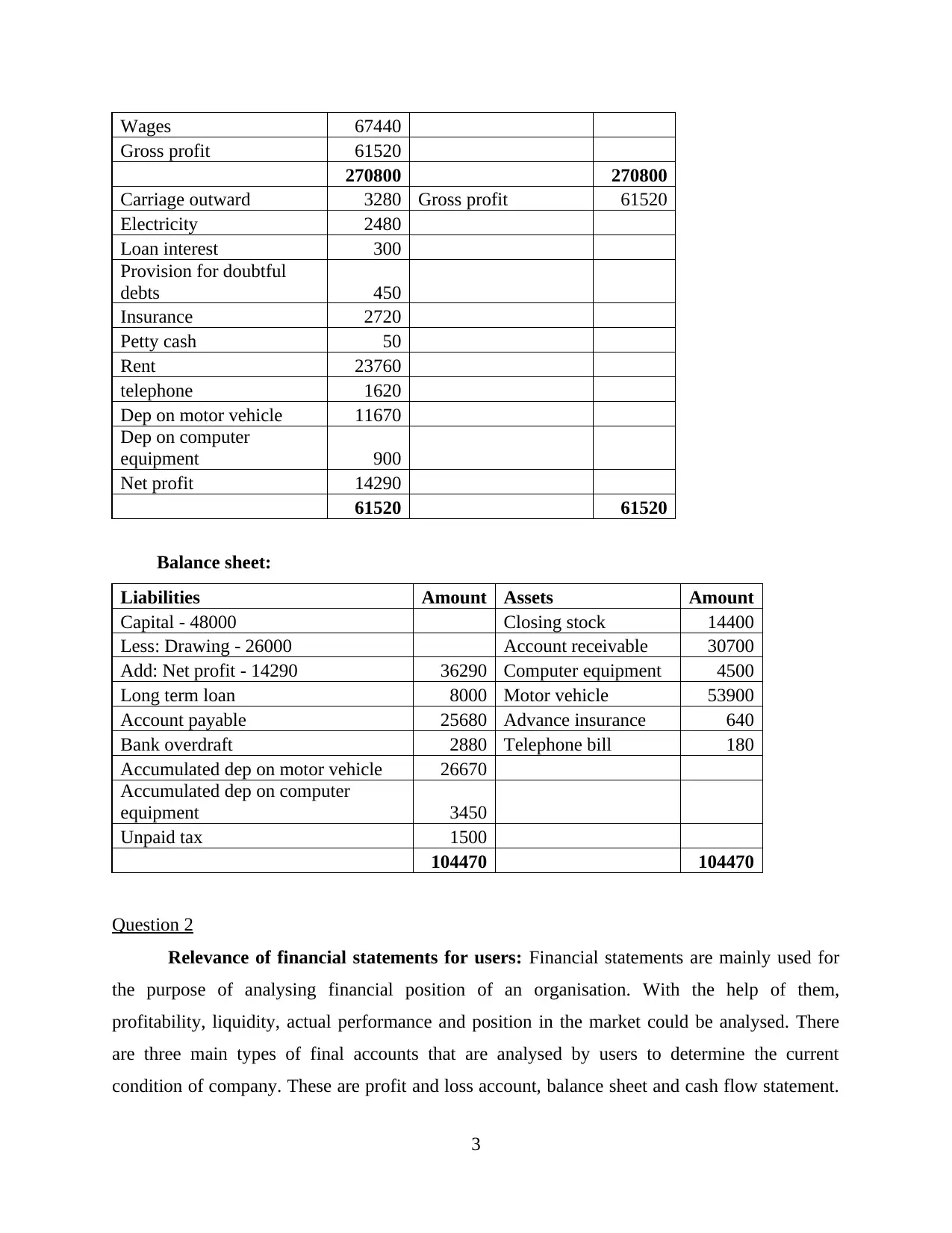
Wages 67440
Gross profit 61520
270800 270800
Carriage outward 3280 Gross profit 61520
Electricity 2480
Loan interest 300
Provision for doubtful
debts 450
Insurance 2720
Petty cash 50
Rent 23760
telephone 1620
Dep on motor vehicle 11670
Dep on computer
equipment 900
Net profit 14290
61520 61520
Balance sheet:
Liabilities Amount Assets Amount
Capital - 48000 Closing stock 14400
Less: Drawing - 26000 Account receivable 30700
Add: Net profit - 14290 36290 Computer equipment 4500
Long term loan 8000 Motor vehicle 53900
Account payable 25680 Advance insurance 640
Bank overdraft 2880 Telephone bill 180
Accumulated dep on motor vehicle 26670
Accumulated dep on computer
equipment 3450
Unpaid tax 1500
104470 104470
Question 2
Relevance of financial statements for users: Financial statements are mainly used for
the purpose of analysing financial position of an organisation. With the help of them,
profitability, liquidity, actual performance and position in the market could be analysed. There
are three main types of final accounts that are analysed by users to determine the current
condition of company. These are profit and loss account, balance sheet and cash flow statement.
3
Gross profit 61520
270800 270800
Carriage outward 3280 Gross profit 61520
Electricity 2480
Loan interest 300
Provision for doubtful
debts 450
Insurance 2720
Petty cash 50
Rent 23760
telephone 1620
Dep on motor vehicle 11670
Dep on computer
equipment 900
Net profit 14290
61520 61520
Balance sheet:
Liabilities Amount Assets Amount
Capital - 48000 Closing stock 14400
Less: Drawing - 26000 Account receivable 30700
Add: Net profit - 14290 36290 Computer equipment 4500
Long term loan 8000 Motor vehicle 53900
Account payable 25680 Advance insurance 640
Bank overdraft 2880 Telephone bill 180
Accumulated dep on motor vehicle 26670
Accumulated dep on computer
equipment 3450
Unpaid tax 1500
104470 104470
Question 2
Relevance of financial statements for users: Financial statements are mainly used for
the purpose of analysing financial position of an organisation. With the help of them,
profitability, liquidity, actual performance and position in the market could be analysed. There
are three main types of final accounts that are analysed by users to determine the current
condition of company. These are profit and loss account, balance sheet and cash flow statement.
3
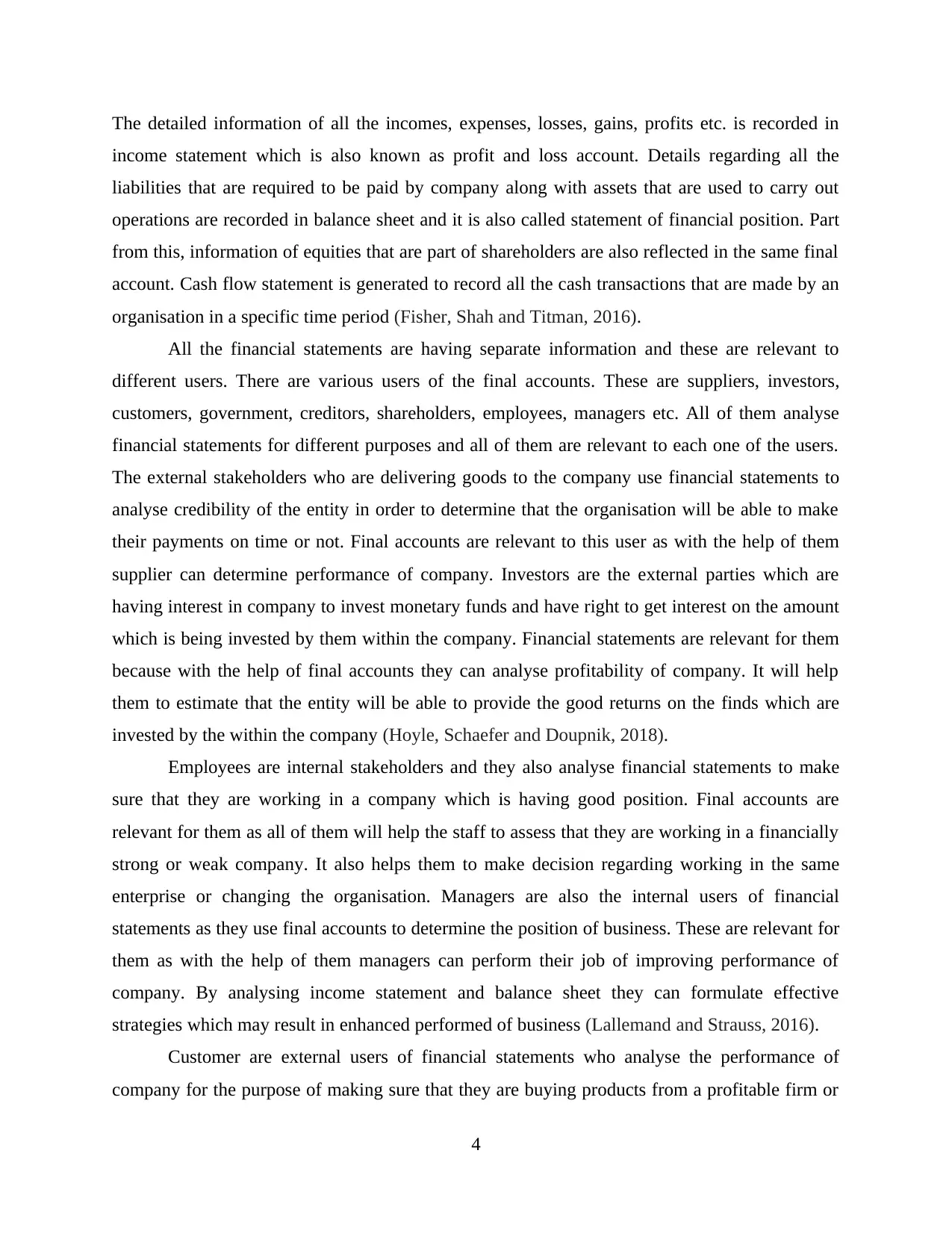
The detailed information of all the incomes, expenses, losses, gains, profits etc. is recorded in
income statement which is also known as profit and loss account. Details regarding all the
liabilities that are required to be paid by company along with assets that are used to carry out
operations are recorded in balance sheet and it is also called statement of financial position. Part
from this, information of equities that are part of shareholders are also reflected in the same final
account. Cash flow statement is generated to record all the cash transactions that are made by an
organisation in a specific time period (Fisher, Shah and Titman, 2016).
All the financial statements are having separate information and these are relevant to
different users. There are various users of the final accounts. These are suppliers, investors,
customers, government, creditors, shareholders, employees, managers etc. All of them analyse
financial statements for different purposes and all of them are relevant to each one of the users.
The external stakeholders who are delivering goods to the company use financial statements to
analyse credibility of the entity in order to determine that the organisation will be able to make
their payments on time or not. Final accounts are relevant to this user as with the help of them
supplier can determine performance of company. Investors are the external parties which are
having interest in company to invest monetary funds and have right to get interest on the amount
which is being invested by them within the company. Financial statements are relevant for them
because with the help of final accounts they can analyse profitability of company. It will help
them to estimate that the entity will be able to provide the good returns on the finds which are
invested by the within the company (Hoyle, Schaefer and Doupnik, 2018).
Employees are internal stakeholders and they also analyse financial statements to make
sure that they are working in a company which is having good position. Final accounts are
relevant for them as all of them will help the staff to assess that they are working in a financially
strong or weak company. It also helps them to make decision regarding working in the same
enterprise or changing the organisation. Managers are also the internal users of financial
statements as they use final accounts to determine the position of business. These are relevant for
them as with the help of them managers can perform their job of improving performance of
company. By analysing income statement and balance sheet they can formulate effective
strategies which may result in enhanced performed of business (Lallemand and Strauss, 2016).
Customer are external users of financial statements who analyse the performance of
company for the purpose of making sure that they are buying products from a profitable firm or
4
income statement which is also known as profit and loss account. Details regarding all the
liabilities that are required to be paid by company along with assets that are used to carry out
operations are recorded in balance sheet and it is also called statement of financial position. Part
from this, information of equities that are part of shareholders are also reflected in the same final
account. Cash flow statement is generated to record all the cash transactions that are made by an
organisation in a specific time period (Fisher, Shah and Titman, 2016).
All the financial statements are having separate information and these are relevant to
different users. There are various users of the final accounts. These are suppliers, investors,
customers, government, creditors, shareholders, employees, managers etc. All of them analyse
financial statements for different purposes and all of them are relevant to each one of the users.
The external stakeholders who are delivering goods to the company use financial statements to
analyse credibility of the entity in order to determine that the organisation will be able to make
their payments on time or not. Final accounts are relevant to this user as with the help of them
supplier can determine performance of company. Investors are the external parties which are
having interest in company to invest monetary funds and have right to get interest on the amount
which is being invested by them within the company. Financial statements are relevant for them
because with the help of final accounts they can analyse profitability of company. It will help
them to estimate that the entity will be able to provide the good returns on the finds which are
invested by the within the company (Hoyle, Schaefer and Doupnik, 2018).
Employees are internal stakeholders and they also analyse financial statements to make
sure that they are working in a company which is having good position. Final accounts are
relevant for them as all of them will help the staff to assess that they are working in a financially
strong or weak company. It also helps them to make decision regarding working in the same
enterprise or changing the organisation. Managers are also the internal users of financial
statements as they use final accounts to determine the position of business. These are relevant for
them as with the help of them managers can perform their job of improving performance of
company. By analysing income statement and balance sheet they can formulate effective
strategies which may result in enhanced performed of business (Lallemand and Strauss, 2016).
Customer are external users of financial statements who analyse the performance of
company for the purpose of making sure that they are buying products from a profitable firm or
4
⊘ This is a preview!⊘
Do you want full access?
Subscribe today to unlock all pages.

Trusted by 1+ million students worldwide
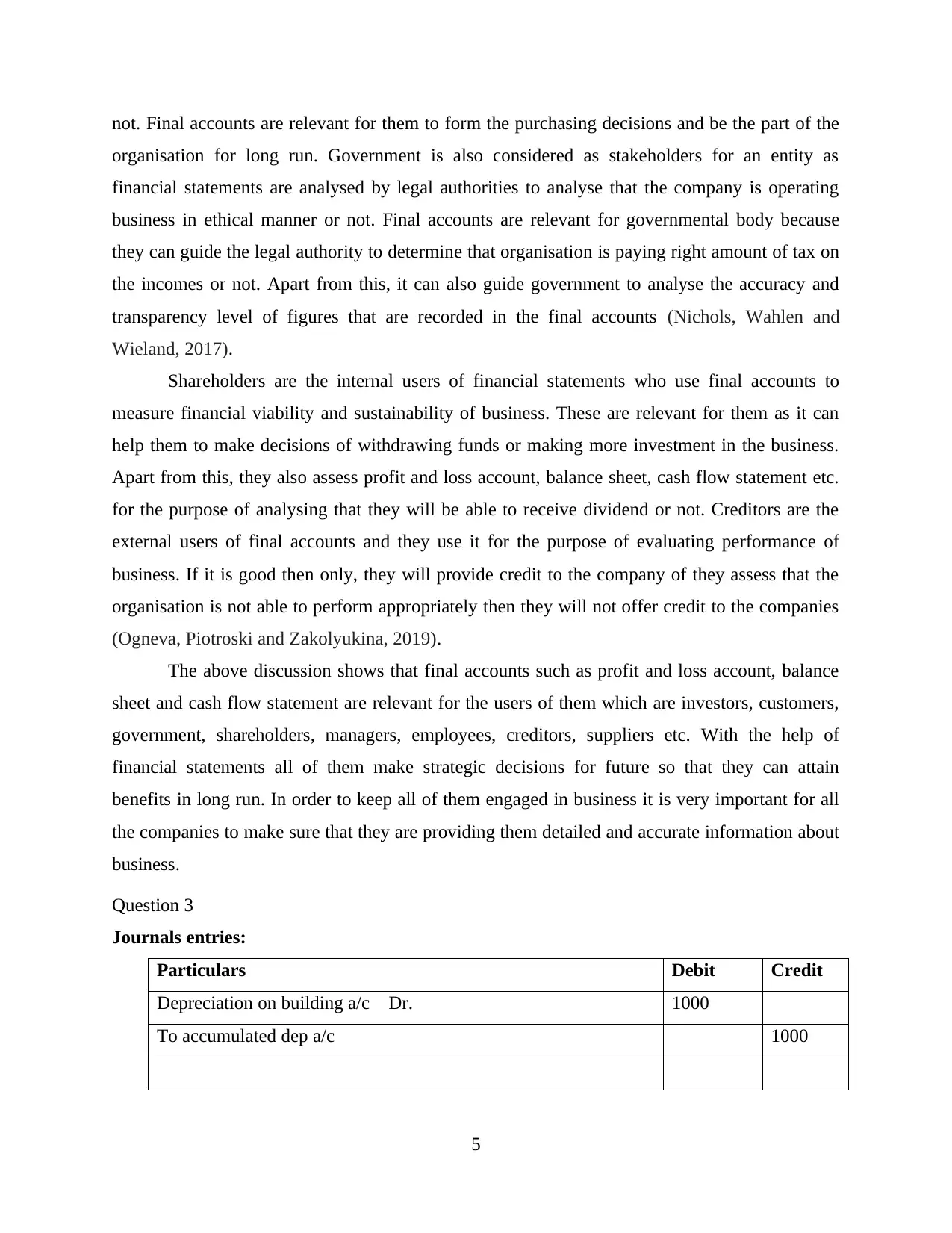
not. Final accounts are relevant for them to form the purchasing decisions and be the part of the
organisation for long run. Government is also considered as stakeholders for an entity as
financial statements are analysed by legal authorities to analyse that the company is operating
business in ethical manner or not. Final accounts are relevant for governmental body because
they can guide the legal authority to determine that organisation is paying right amount of tax on
the incomes or not. Apart from this, it can also guide government to analyse the accuracy and
transparency level of figures that are recorded in the final accounts (Nichols, Wahlen and
Wieland, 2017).
Shareholders are the internal users of financial statements who use final accounts to
measure financial viability and sustainability of business. These are relevant for them as it can
help them to make decisions of withdrawing funds or making more investment in the business.
Apart from this, they also assess profit and loss account, balance sheet, cash flow statement etc.
for the purpose of analysing that they will be able to receive dividend or not. Creditors are the
external users of final accounts and they use it for the purpose of evaluating performance of
business. If it is good then only, they will provide credit to the company of they assess that the
organisation is not able to perform appropriately then they will not offer credit to the companies
(Ogneva, Piotroski and Zakolyukina, 2019).
The above discussion shows that final accounts such as profit and loss account, balance
sheet and cash flow statement are relevant for the users of them which are investors, customers,
government, shareholders, managers, employees, creditors, suppliers etc. With the help of
financial statements all of them make strategic decisions for future so that they can attain
benefits in long run. In order to keep all of them engaged in business it is very important for all
the companies to make sure that they are providing them detailed and accurate information about
business.
Question 3
Journals entries:
Particulars Debit Credit
Depreciation on building a/c Dr. 1000
To accumulated dep a/c 1000
5
organisation for long run. Government is also considered as stakeholders for an entity as
financial statements are analysed by legal authorities to analyse that the company is operating
business in ethical manner or not. Final accounts are relevant for governmental body because
they can guide the legal authority to determine that organisation is paying right amount of tax on
the incomes or not. Apart from this, it can also guide government to analyse the accuracy and
transparency level of figures that are recorded in the final accounts (Nichols, Wahlen and
Wieland, 2017).
Shareholders are the internal users of financial statements who use final accounts to
measure financial viability and sustainability of business. These are relevant for them as it can
help them to make decisions of withdrawing funds or making more investment in the business.
Apart from this, they also assess profit and loss account, balance sheet, cash flow statement etc.
for the purpose of analysing that they will be able to receive dividend or not. Creditors are the
external users of final accounts and they use it for the purpose of evaluating performance of
business. If it is good then only, they will provide credit to the company of they assess that the
organisation is not able to perform appropriately then they will not offer credit to the companies
(Ogneva, Piotroski and Zakolyukina, 2019).
The above discussion shows that final accounts such as profit and loss account, balance
sheet and cash flow statement are relevant for the users of them which are investors, customers,
government, shareholders, managers, employees, creditors, suppliers etc. With the help of
financial statements all of them make strategic decisions for future so that they can attain
benefits in long run. In order to keep all of them engaged in business it is very important for all
the companies to make sure that they are providing them detailed and accurate information about
business.
Question 3
Journals entries:
Particulars Debit Credit
Depreciation on building a/c Dr. 1000
To accumulated dep a/c 1000
5
Paraphrase This Document
Need a fresh take? Get an instant paraphrase of this document with our AI Paraphraser
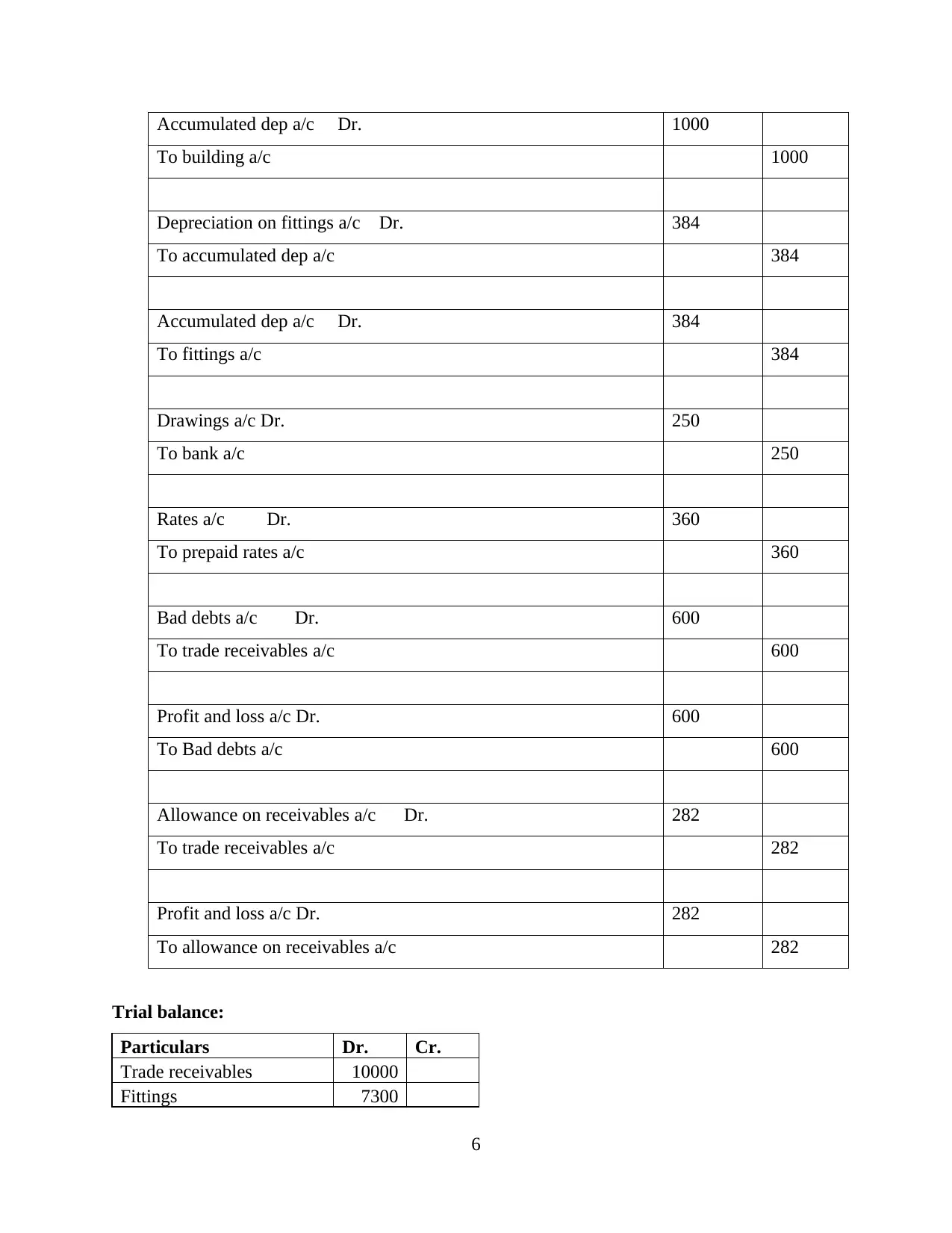
Accumulated dep a/c Dr. 1000
To building a/c 1000
Depreciation on fittings a/c Dr. 384
To accumulated dep a/c 384
Accumulated dep a/c Dr. 384
To fittings a/c 384
Drawings a/c Dr. 250
To bank a/c 250
Rates a/c Dr. 360
To prepaid rates a/c 360
Bad debts a/c Dr. 600
To trade receivables a/c 600
Profit and loss a/c Dr. 600
To Bad debts a/c 600
Allowance on receivables a/c Dr. 282
To trade receivables a/c 282
Profit and loss a/c Dr. 282
To allowance on receivables a/c 282
Trial balance:
Particulars Dr. Cr.
Trade receivables 10000
Fittings 7300
6
To building a/c 1000
Depreciation on fittings a/c Dr. 384
To accumulated dep a/c 384
Accumulated dep a/c Dr. 384
To fittings a/c 384
Drawings a/c Dr. 250
To bank a/c 250
Rates a/c Dr. 360
To prepaid rates a/c 360
Bad debts a/c Dr. 600
To trade receivables a/c 600
Profit and loss a/c Dr. 600
To Bad debts a/c 600
Allowance on receivables a/c Dr. 282
To trade receivables a/c 282
Profit and loss a/c Dr. 282
To allowance on receivables a/c 282
Trial balance:
Particulars Dr. Cr.
Trade receivables 10000
Fittings 7300
6
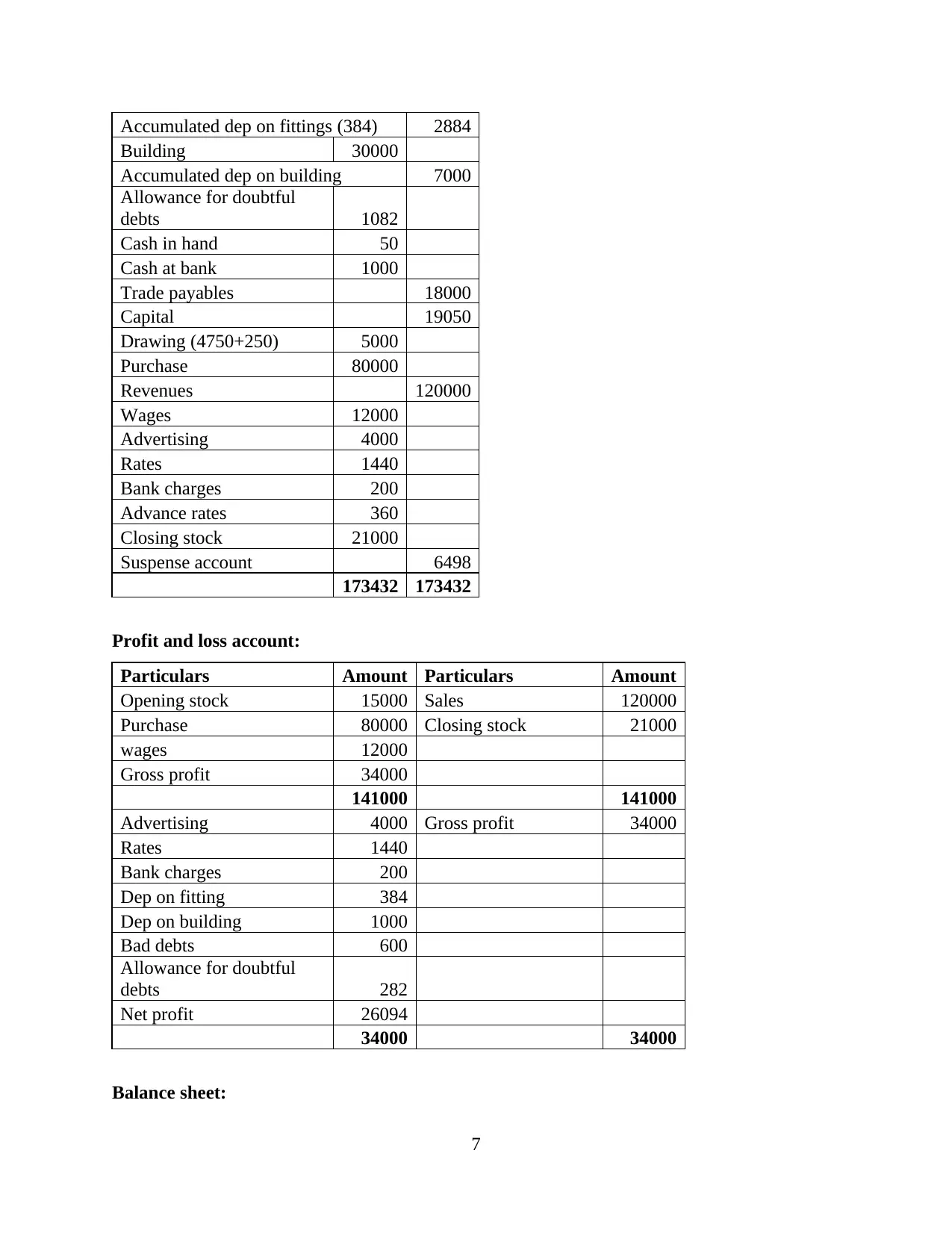
Accumulated dep on fittings (384) 2884
Building 30000
Accumulated dep on building 7000
Allowance for doubtful
debts 1082
Cash in hand 50
Cash at bank 1000
Trade payables 18000
Capital 19050
Drawing (4750+250) 5000
Purchase 80000
Revenues 120000
Wages 12000
Advertising 4000
Rates 1440
Bank charges 200
Advance rates 360
Closing stock 21000
Suspense account 6498
173432 173432
Profit and loss account:
Particulars Amount Particulars Amount
Opening stock 15000 Sales 120000
Purchase 80000 Closing stock 21000
wages 12000
Gross profit 34000
141000 141000
Advertising 4000 Gross profit 34000
Rates 1440
Bank charges 200
Dep on fitting 384
Dep on building 1000
Bad debts 600
Allowance for doubtful
debts 282
Net profit 26094
34000 34000
Balance sheet:
7
Building 30000
Accumulated dep on building 7000
Allowance for doubtful
debts 1082
Cash in hand 50
Cash at bank 1000
Trade payables 18000
Capital 19050
Drawing (4750+250) 5000
Purchase 80000
Revenues 120000
Wages 12000
Advertising 4000
Rates 1440
Bank charges 200
Advance rates 360
Closing stock 21000
Suspense account 6498
173432 173432
Profit and loss account:
Particulars Amount Particulars Amount
Opening stock 15000 Sales 120000
Purchase 80000 Closing stock 21000
wages 12000
Gross profit 34000
141000 141000
Advertising 4000 Gross profit 34000
Rates 1440
Bank charges 200
Dep on fitting 384
Dep on building 1000
Bad debts 600
Allowance for doubtful
debts 282
Net profit 26094
34000 34000
Balance sheet:
7
⊘ This is a preview!⊘
Do you want full access?
Subscribe today to unlock all pages.

Trusted by 1+ million students worldwide
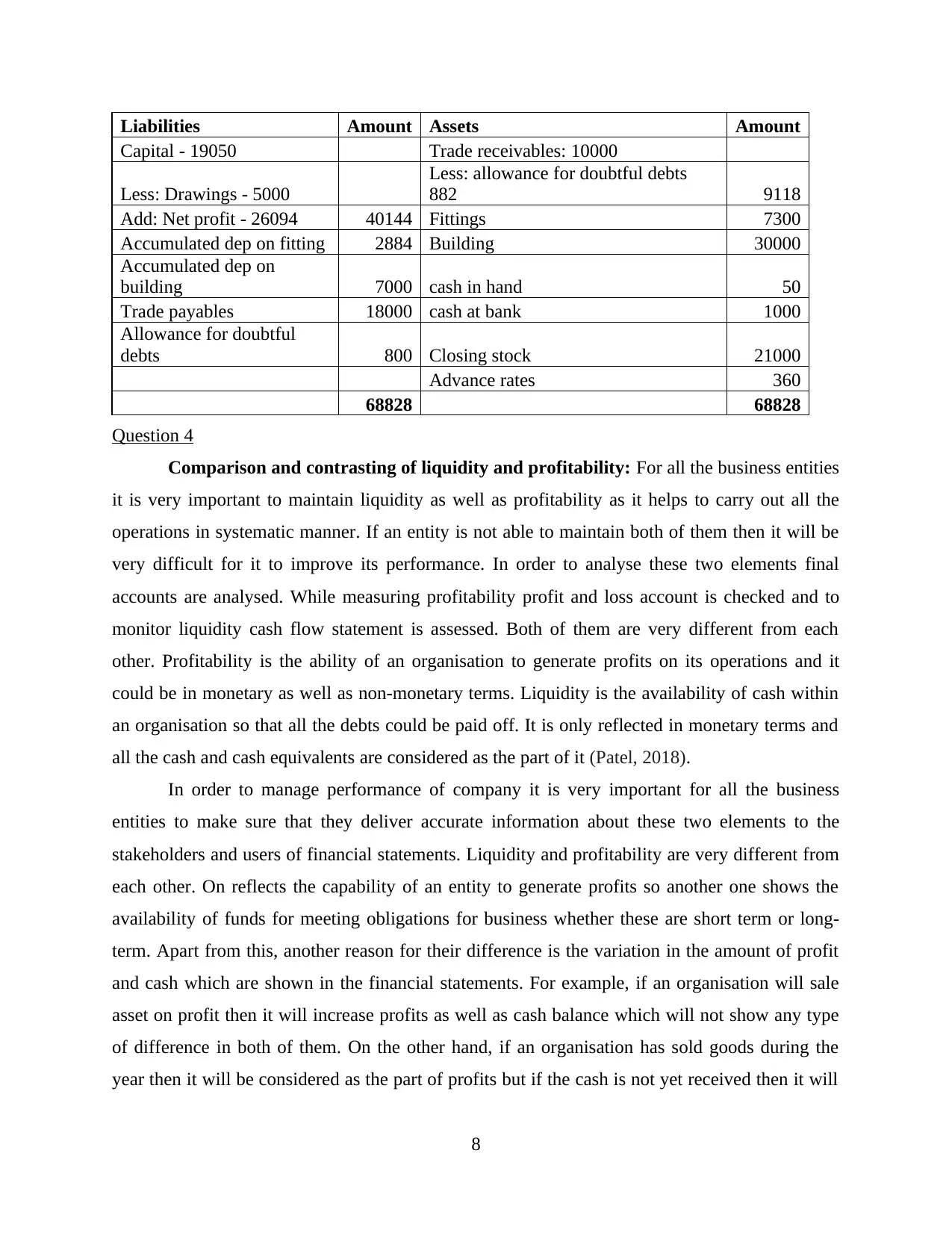
Liabilities Amount Assets Amount
Capital - 19050 Trade receivables: 10000
Less: Drawings - 5000
Less: allowance for doubtful debts
882 9118
Add: Net profit - 26094 40144 Fittings 7300
Accumulated dep on fitting 2884 Building 30000
Accumulated dep on
building 7000 cash in hand 50
Trade payables 18000 cash at bank 1000
Allowance for doubtful
debts 800 Closing stock 21000
Advance rates 360
68828 68828
Question 4
Comparison and contrasting of liquidity and profitability: For all the business entities
it is very important to maintain liquidity as well as profitability as it helps to carry out all the
operations in systematic manner. If an entity is not able to maintain both of them then it will be
very difficult for it to improve its performance. In order to analyse these two elements final
accounts are analysed. While measuring profitability profit and loss account is checked and to
monitor liquidity cash flow statement is assessed. Both of them are very different from each
other. Profitability is the ability of an organisation to generate profits on its operations and it
could be in monetary as well as non-monetary terms. Liquidity is the availability of cash within
an organisation so that all the debts could be paid off. It is only reflected in monetary terms and
all the cash and cash equivalents are considered as the part of it (Patel, 2018).
In order to manage performance of company it is very important for all the business
entities to make sure that they deliver accurate information about these two elements to the
stakeholders and users of financial statements. Liquidity and profitability are very different from
each other. On reflects the capability of an entity to generate profits so another one shows the
availability of funds for meeting obligations for business whether these are short term or long-
term. Apart from this, another reason for their difference is the variation in the amount of profit
and cash which are shown in the financial statements. For example, if an organisation will sale
asset on profit then it will increase profits as well as cash balance which will not show any type
of difference in both of them. On the other hand, if an organisation has sold goods during the
year then it will be considered as the part of profits but if the cash is not yet received then it will
8
Capital - 19050 Trade receivables: 10000
Less: Drawings - 5000
Less: allowance for doubtful debts
882 9118
Add: Net profit - 26094 40144 Fittings 7300
Accumulated dep on fitting 2884 Building 30000
Accumulated dep on
building 7000 cash in hand 50
Trade payables 18000 cash at bank 1000
Allowance for doubtful
debts 800 Closing stock 21000
Advance rates 360
68828 68828
Question 4
Comparison and contrasting of liquidity and profitability: For all the business entities
it is very important to maintain liquidity as well as profitability as it helps to carry out all the
operations in systematic manner. If an entity is not able to maintain both of them then it will be
very difficult for it to improve its performance. In order to analyse these two elements final
accounts are analysed. While measuring profitability profit and loss account is checked and to
monitor liquidity cash flow statement is assessed. Both of them are very different from each
other. Profitability is the ability of an organisation to generate profits on its operations and it
could be in monetary as well as non-monetary terms. Liquidity is the availability of cash within
an organisation so that all the debts could be paid off. It is only reflected in monetary terms and
all the cash and cash equivalents are considered as the part of it (Patel, 2018).
In order to manage performance of company it is very important for all the business
entities to make sure that they deliver accurate information about these two elements to the
stakeholders and users of financial statements. Liquidity and profitability are very different from
each other. On reflects the capability of an entity to generate profits so another one shows the
availability of funds for meeting obligations for business whether these are short term or long-
term. Apart from this, another reason for their difference is the variation in the amount of profit
and cash which are shown in the financial statements. For example, if an organisation will sale
asset on profit then it will increase profits as well as cash balance which will not show any type
of difference in both of them. On the other hand, if an organisation has sold goods during the
year then it will be considered as the part of profits but if the cash is not yet received then it will
8
Paraphrase This Document
Need a fresh take? Get an instant paraphrase of this document with our AI Paraphraser
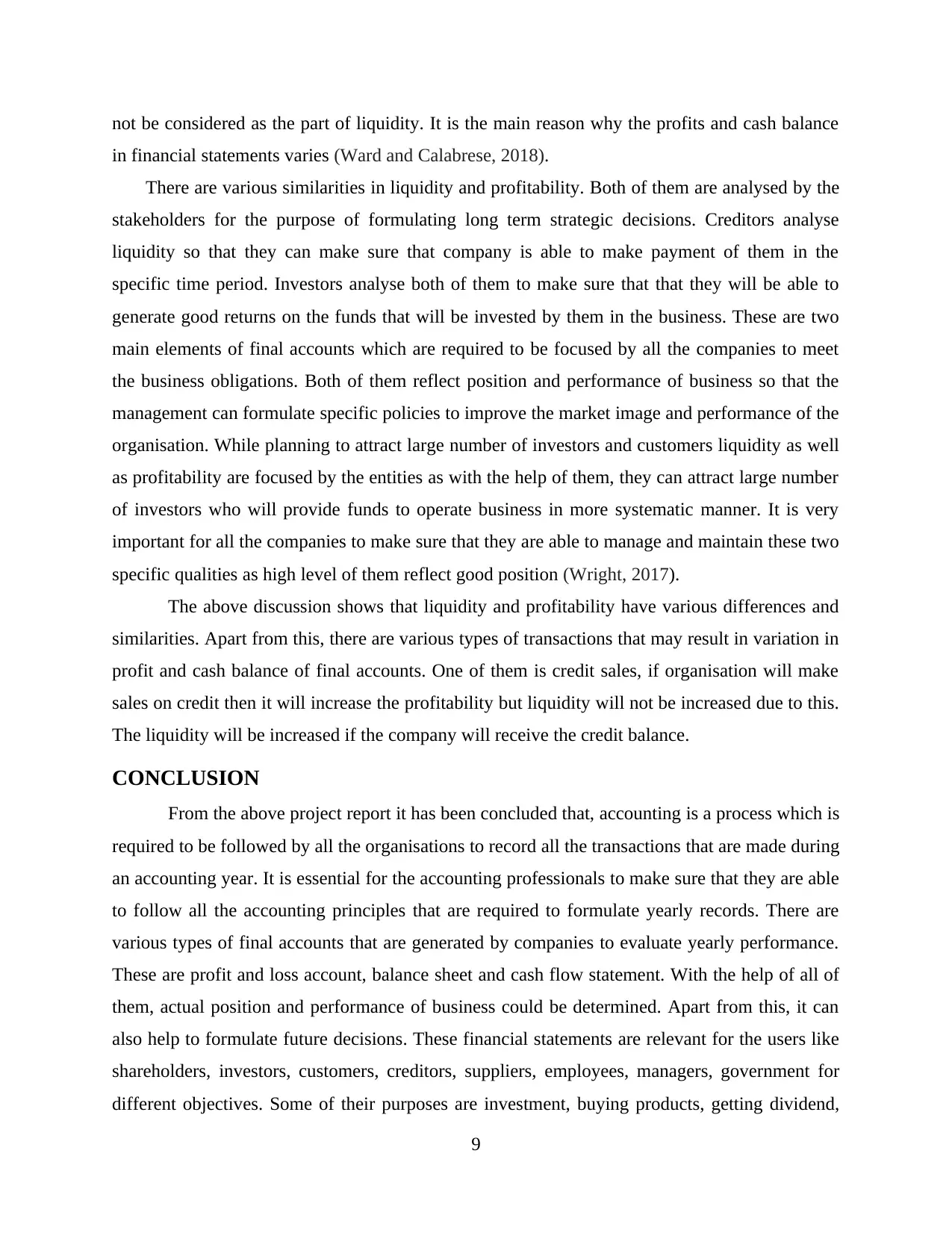
not be considered as the part of liquidity. It is the main reason why the profits and cash balance
in financial statements varies (Ward and Calabrese, 2018).
There are various similarities in liquidity and profitability. Both of them are analysed by the
stakeholders for the purpose of formulating long term strategic decisions. Creditors analyse
liquidity so that they can make sure that company is able to make payment of them in the
specific time period. Investors analyse both of them to make sure that that they will be able to
generate good returns on the funds that will be invested by them in the business. These are two
main elements of final accounts which are required to be focused by all the companies to meet
the business obligations. Both of them reflect position and performance of business so that the
management can formulate specific policies to improve the market image and performance of the
organisation. While planning to attract large number of investors and customers liquidity as well
as profitability are focused by the entities as with the help of them, they can attract large number
of investors who will provide funds to operate business in more systematic manner. It is very
important for all the companies to make sure that they are able to manage and maintain these two
specific qualities as high level of them reflect good position (Wright, 2017).
The above discussion shows that liquidity and profitability have various differences and
similarities. Apart from this, there are various types of transactions that may result in variation in
profit and cash balance of final accounts. One of them is credit sales, if organisation will make
sales on credit then it will increase the profitability but liquidity will not be increased due to this.
The liquidity will be increased if the company will receive the credit balance.
CONCLUSION
From the above project report it has been concluded that, accounting is a process which is
required to be followed by all the organisations to record all the transactions that are made during
an accounting year. It is essential for the accounting professionals to make sure that they are able
to follow all the accounting principles that are required to formulate yearly records. There are
various types of final accounts that are generated by companies to evaluate yearly performance.
These are profit and loss account, balance sheet and cash flow statement. With the help of all of
them, actual position and performance of business could be determined. Apart from this, it can
also help to formulate future decisions. These financial statements are relevant for the users like
shareholders, investors, customers, creditors, suppliers, employees, managers, government for
different objectives. Some of their purposes are investment, buying products, getting dividend,
9
in financial statements varies (Ward and Calabrese, 2018).
There are various similarities in liquidity and profitability. Both of them are analysed by the
stakeholders for the purpose of formulating long term strategic decisions. Creditors analyse
liquidity so that they can make sure that company is able to make payment of them in the
specific time period. Investors analyse both of them to make sure that that they will be able to
generate good returns on the funds that will be invested by them in the business. These are two
main elements of final accounts which are required to be focused by all the companies to meet
the business obligations. Both of them reflect position and performance of business so that the
management can formulate specific policies to improve the market image and performance of the
organisation. While planning to attract large number of investors and customers liquidity as well
as profitability are focused by the entities as with the help of them, they can attract large number
of investors who will provide funds to operate business in more systematic manner. It is very
important for all the companies to make sure that they are able to manage and maintain these two
specific qualities as high level of them reflect good position (Wright, 2017).
The above discussion shows that liquidity and profitability have various differences and
similarities. Apart from this, there are various types of transactions that may result in variation in
profit and cash balance of final accounts. One of them is credit sales, if organisation will make
sales on credit then it will increase the profitability but liquidity will not be increased due to this.
The liquidity will be increased if the company will receive the credit balance.
CONCLUSION
From the above project report it has been concluded that, accounting is a process which is
required to be followed by all the organisations to record all the transactions that are made during
an accounting year. It is essential for the accounting professionals to make sure that they are able
to follow all the accounting principles that are required to formulate yearly records. There are
various types of final accounts that are generated by companies to evaluate yearly performance.
These are profit and loss account, balance sheet and cash flow statement. With the help of all of
them, actual position and performance of business could be determined. Apart from this, it can
also help to formulate future decisions. These financial statements are relevant for the users like
shareholders, investors, customers, creditors, suppliers, employees, managers, government for
different objectives. Some of their purposes are investment, buying products, getting dividend,
9
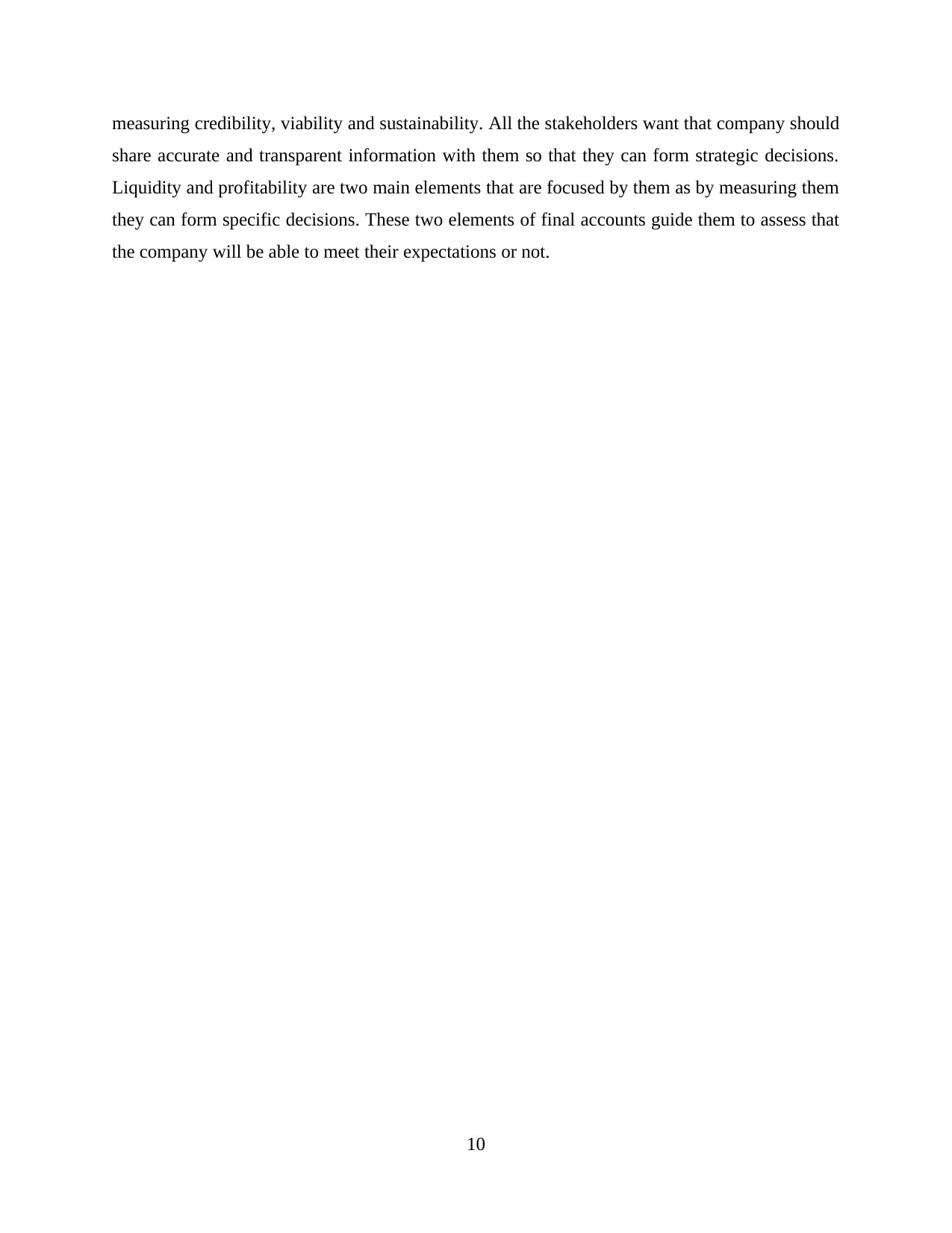
measuring credibility, viability and sustainability. All the stakeholders want that company should
share accurate and transparent information with them so that they can form strategic decisions.
Liquidity and profitability are two main elements that are focused by them as by measuring them
they can form specific decisions. These two elements of final accounts guide them to assess that
the company will be able to meet their expectations or not.
10
share accurate and transparent information with them so that they can form strategic decisions.
Liquidity and profitability are two main elements that are focused by them as by measuring them
they can form specific decisions. These two elements of final accounts guide them to assess that
the company will be able to meet their expectations or not.
10
⊘ This is a preview!⊘
Do you want full access?
Subscribe today to unlock all pages.

Trusted by 1+ million students worldwide
1 out of 13
Related Documents
Your All-in-One AI-Powered Toolkit for Academic Success.
+13062052269
info@desklib.com
Available 24*7 on WhatsApp / Email
![[object Object]](/_next/static/media/star-bottom.7253800d.svg)
Unlock your academic potential
Copyright © 2020–2025 A2Z Services. All Rights Reserved. Developed and managed by ZUCOL.




